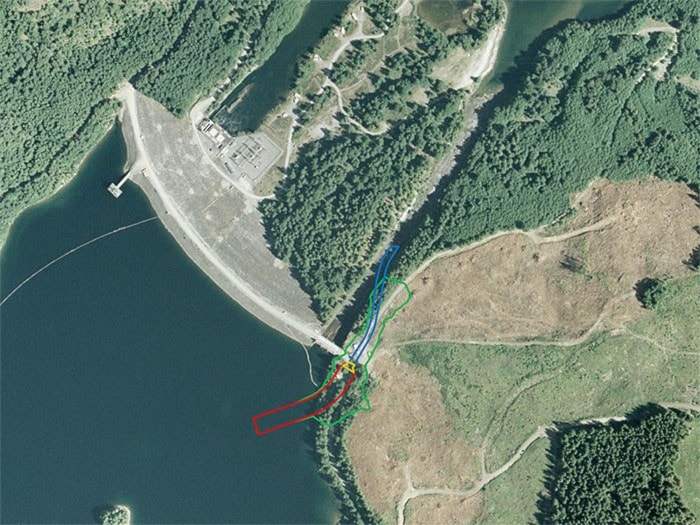The largest dam on the Campbell River hydroelectric system will be getting a major dam safety investment that is designed to provide safe control of the reservoir after a major earthquake.
This first project to be initiated at Strathcona Dam is to construct a new Low Level Outlet to allow for deep drawdown of the Upper Campbell Reservoir/Buttle Lake, either by constructing an underground tunnel or an open cut excavation on the right bank or south side of the dam site, according a to a BC Hydro press release. This new tunnel or channel will then be able to lower the reservoir water level post-earthquake. The lowering of the reservoir level would ease water pressure on the upstream side of the dam should it sustain damage during an earthquake. This would allow for proactive reservoir control and significantly lower the risk of an uncontrolled release.
The Strathcona Dam is a 54-metre high earthfill dam with a power tunnel that delivers water beneath the base of the dam to a generating station on the downstream side. On the right bank of the dam, there are three spillway gates used for flood risk management during large storm events.
“The dam is safe day to day,” says BC Hydro spokesperson, Stephen Watson. “The concern for us is when a large earthquake hits, if the dam and power tunnel undergoes displacements and become damaged, and given how high up on the dam the spillway gates are located, we would be unable to lower the reservoir level very much, if at all. With the existing facility, we have no way of suitably lowering the reservoir to ease pressure on the dam. This project will provide us with that needed flexibility for dam safety and public safety in protecting downstream community interests.”
Capital upgrades are also planned at the John Hart dam, and at the Ladore Dam, BC Hydro is planning to seismically upgrade the three spillway gates. When all these works are completed, BC Hydro says it will greatly improve their ability to manage the post-earthquake water flow releases.
BC Hydro looked at various options before narrowing down to five different outlet options located on either side of the dam as part of its Strathcona Dam Low Level Outlet Project. At the end of 2016, they decided to proceed with the two most promising options both located on the south side of the dam. BC Hydro has been consulting First Nations, and engaging stakeholders through the Campbell River System Hydroelectric facilities Liaison Committee throughout this option development stage.
“We will now be spending the next 18 months or so going into feasibility design to better develop the scope of the project,” says Watson. “This includes having a tunnel in bedrock that would go deep into the reservoir and discharge water into the existing spillway channel, or having an open-cut channel that would be quite deep to be able to lower the reservoir. Both options also gives us the flexibility to convert the existing spillway into an overflow spillway, which would be more reliable than the existing gates given the age and seismic concerns.”
Investigative drilling this summer will help determine the bedrock and soil conditions at the site.
Watson says BC Hydro is considering the needs of the entire facility in its planning process including any future plans to seismically upgrade the earthfill dam, if required, and replace the existing generating station with a new station depending on the condition of the existing equipment and future power needs. Such work may take place over 20 years, with the schedule dependent on the ongoing performance of the existing dam and generating station, and future power needs.
The new tunnel or channel construction work could start as early as early 2021 pending BC Hydro management approvals and regulatory approvals, including the BC Utilities Commission. The construction work may last about three years.
BC Hydro says it will continue to engage the community on the project. There are also social issues to consider such as a potential closure to the campground below the dam and to the road across the dam during the construction period. If you have any questions about the project, please contact Stephen Watson at steve.watson@bchydro.com or 1-250-755-4795.
